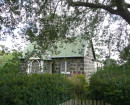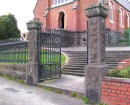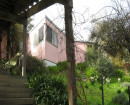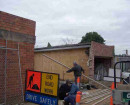Commonwealth Munitions Housing Estate
Devonshire Road and Duke Street SUNSHINE, Brimbank City
-
Add to tour
You must log in to do that.
-
Share
-
Shortlist place
You must log in to do that.
- Download report
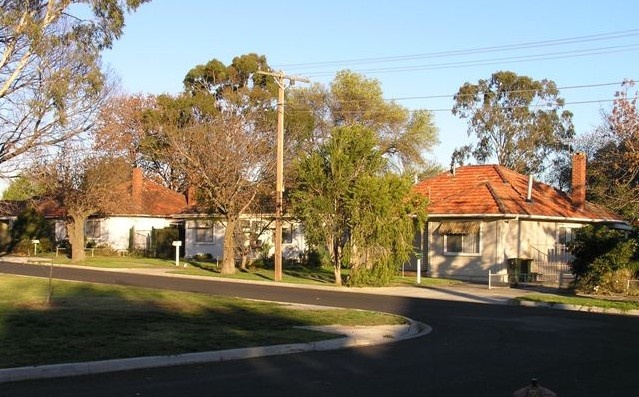

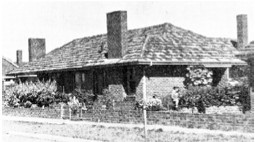
Statement of Significance
Statement of SIgnificance
This estate is of national historical significance as part of a Federal Government-initiated housing scheme for workers in the munitions industry in the Maribyrnong-Footscray area, the largest concentration of defence production establishments in the whole of Australia, when World War Two began. The Housing Commission of Victoria acted as the construction authority, and the houses were designed by architect Marcus Barlow. It was possibly the first major Commonwealth war housing scheme to be undertaken and was one of the few largescale housing schemes undertaken in Victoria during World War Two. This part of the estate included the main recreational and community area, serving the whole estate of 234 houses
.
-
-
Commonwealth Munitions Housing Estate - Physical Description 1
Description
Part of an estate of concrete houses and brick semi-detached houses built by the Commonwealth to house munitions workers, a total of 234 houses. The development extends across Duke Street with a substantial number of houses in Braybrook, now the City of Maribyrnong (58%).
The Brimbank precinct (98 houses) comprises houses in Baker Street, Nixon Street, Yewers Street, Cobrey Street, Duke Street, Devonshire Road and around Lowe Crescent. A characteristic design element of the area is the use of concrete roads and the curving Lowe Crescent on a small irregular shaped square with landscaping of contemporary date and also later periods. The houses themselves are generally hipped roof with overhanging eaves. The Nixon Street, Baker Street, Yewers Street and Lowe Crescent houses are concrete-walled, while the others are generally red brick, with a series of long duplexes in Duke Street and Cobrey Street.
The War Workers Housing Scheme estate appears to have survived virtually intact, with only two houses demolished and replaced by modern dwellings. A number of the houses are brick, most of them semi-detached residences or 'maisonettes', quite different in design from anything else in the municipality. The brick houses are mainly on the western side of Duke Street, the eastern side of Cobrey Street and a section of the south side of Devonshire Road. Most of the remaining houses are concrete, detached residences, especially in Yewers Street, Lowe Crescent, Baker Street and Nixon Street. All the houses have tiled roofs. It appears that a total of 97 houses are remaining out of the original 98). The houses are as follows:- 47-77 Duke Street, west side (16 houses) - brick 2-22 Cobrey Street, east side (11 houses) - brick 112-138 Devonshire Road, south side (14 houses) - some brick, some concrete 2-32 Nixon Street, south side (16 houses) - some brick, some concrete 1-27 Lowe Crescent, north side (14 houses) - some concrete, some brick 2-16 Yewers Street, east side (8 houses) - concrete 1-7, 11-15 Yewers Street, west side (7 houses) - concrete 1-15 Baker Street west side (8 houses) - concrete 14-16 Baker Street (2 houses) - concrete 10 Monash Street (1 house) - brick.
The houses are largely intact, with the primary change seen being the replacement of original timber windows with aluminium units (at 1, 11, 13, 14 Baker St; 12, 14 Cobrey St; 112-116A, 122, 128, 130, 134 Devonshire Rd; 57, 65 Duke St; 1, 3, 7, 11, 13, 19, 21, 27 Lowe Cr; 10 Monash St; 4, 6, 10, 14, 16, 22 Nixon St; 3, 4, 5, 6, 10-16 Yewers St). A number of the small front porches have also been enclosed or otherwise altered (at 9, 11 Baker St; 8, 16 Cobrey St; 122, 128, 134, 138 Devonshire Rd; 57, 63, 65, 75, 77 Duke St; 3, 9-13 Lowe Cr; 4, 6, 16 Lowe Cr; 26 Nixon St; 2, 3 Yewers St).
A number of the houses retain one of the two original front fence types, both of them quite low in height. Some brick houses retain a low clinker brick wall (at 126 & 132 Devonshire Rd, 47, 53, 67, 69-73 Duke St, 28, 32 Nixon St). Concrete houses generally have low pipe and cyclone wire fences (at 1, 3, 11 Baker St; 112-116A Devonshire Rd; 7 Lowe Cr; 2-12 Nixon St; 2, 5-7, 6-10, 13, 16 Yewers St), as do some of the brick houses on the east side of Duke Street.
The surviving houses that are contributory to the precinct include the following:
ADDRESS, DATE, DESCRIPTION
1 Baker Street, 1942, Concrete detached house
3 Baker Street, 1942, Concrete detached house
7 Baker Street, 1942, Concrete detached house - clad with fake brick fibre cement panels
9 Baker Street, 1942, Concrete detached house
11 Baker Street, 1942, Concrete detached house
13 Baker Street, 1942, Concrete detached house
14 Baker Street, 1942, Concrete detached house
16 Baker Street, 1942, Concrete detached house - dual occupancy with 2000c rendered two
storey
2 Cobrey Street, 1942, brick duplex
4 Cobrey Street, 1942, brick duplex
6 Cobrey Street, 1942, brick duplex
8 Cobrey Street, 1942, brick duplex
10 Cobrey Street, 1942, brick duplex
12 Cobrey Street, 1942, brick duplex
14 Cobrey Street, 1942, brick duplex
16 Cobrey Street, 1942, brick duplex
18 Cobrey Street, 1942, brick duplex
20 Cobrey Street, 1942, brick duplex
22 Cobrey Street, 1942, brick duplex
112 Devonshire Rd., 1942, Concrete detached house
114 Devonshire Rd., 1942, Concrete detached house
116 Devonshire Rd., 1942, Concrete detached house
116A Devonshire Road, 1942, Concrete detached house
118 Devonshire Rd., 1942, Concrete detached house
120 Devonshire Rd., 1942, Concrete detached house
122 Devonshire Rd., 1942, Concrete detached house
124 Devonshire Rd., 1942, brick duplex
126 Devonshire Rd., 1942, brick duplex
128 Devonshire Rd., 1942, brick duplex
130 Devonshire Rd., 1942, brick duplex
132 Devonshire Rd., 1942, brick duplex
134 Devonshire Rd., 1942, brick duplex
136 Devonshire Rd., 1942, brick duplex
138 Devonshire Rd., 1942, brick duplex
47 Duke Street, 1942, brick duplex
49 Duke Street, 1942, brick duplex
51 Duke Street, 1942, brick duplex
53 Duke Street, 1942, brick duplex
55 Duke Street, 1942, brick duplex
57 Duke Street, 1942, brick duplex
63 Duke Street, 1942, brick duplex
65 Duke Street, 1942, brick duplex
67 Duke Street, 1942, brick duplex
69 Duke Street, 1942, brick duplex
71 Duke Street, 1942, brick duplex
73 Duke Street, 1942, brick duplex
75 Duke Street, 1942, brick duplex, recently rendered
77 Duke Street, 1940s, brick detached house
1 Lowe Crescent, 1942, Concrete detached house, brick veneer at rear - No 12 Baker Street.
3 Lowe Crescent, 1942, Concrete detached house
5 Lowe Crescent, 1942, Concrete detached house
7 Lowe Crescent, 1942, Concrete detached house
9 Lowe Crescent, 1942, Concrete detached house
11 Lowe Crescent, 1942, Concrete detached house
13 Lowe Crescent, 1942, brick duplex
15 Lowe Crescent, 1942, brick duplex
17 Lowe Crescent, 1942, brick duplex
19 Lowe Crescent, 1942, brick duplex
21 Lowe Crescent, 1942, brick duplex
23 Lowe Crescent, 1942, brick duplex
25 Lowe Crescent, 1942, brick duplex
27 Lowe Crescent, 1942, brick duplex
10 Monash Street, 1942, brick duplex
2 Nixon Street, 1942, Concrete detached house
4 Nixon Street, 1942, Concrete detached house
6 Nixon Street, 1942, Concrete detached house
8 Nixon Street, 1942, Concrete detached house
10 Nixon Street, 1942, Concrete detached house
12 Nixon Street, 1942, Concrete detached house
14 Nixon Street, 1942, Concrete detached house
16 Nixon Street, 1942, Concrete detached house
18 Nixon Street, 1942, Concrete detached house
20 Nixon Street, 1942, Concrete detached house
22 Nixon Street, 1942, Concrete detached house
24 Nixon Street, 1942, Concrete detached house
26 Nixon Street, 1942, brick duplex
28 Nixon Street, 1942, brick duplex
30 Nixon Street, 1942, brick detached house
32 Nixon Street, 1942, brick duplex
2 Yewers Street, 1942, Concrete detached house
3 Yewers Street, 1942, Concrete detached house
4 Yewers Street, 1942, Concrete detached house
5 Yewers Street, 1942, Concrete detached house
6 Yewers Street, 1942, Concrete detached house
7 Yewers Street, 1942, Concrete detached house
8 Yewers Street, 1942, Concrete detached house
10 Yewers Street, 1942, Concrete detached house
11 Yewers Street, 1942, Concrete detached house
12 Yewers Street, 1942, Concrete detached house
13 Yewers Street, 1942, Concrete detached house
14 Yewers Street, 1942, Concrete detached house
16 Yewers Street, 1942, Concrete detached house - dual occupancy with c2000 brick veneer at
rear
17 Yewers Street, 1942, Concrete detached house
A number of places, which formerly contributed to the historical significance of the precinct, have been demolished or extensively altered in the last decade or so. These include the following:
5 & 5A Baker Street, now modern semi detached brick veneers, 2000s
12 Baker Street, dual occupancy with rear of 1 Lowe Crescent rendered two storey brick veneer
2000c
15 Baker Street, dual occupancy at the rear of 116A Devonshire Road.
16A Baker Street, dual occupancy at the rear of 16 Baker Street.
59 Duke Street, vacant
61 Duke Street, vacant - new development
8 McGrath Street, dual occupancy at the rear of 7 Yewers Street.
1 Yewers Street, mock colonial brick veneer units, 2000c
9 Yewers Street, 2 storey brown brick veneer, 1980s
15 Yewers Street, dual occupancy at the rear of 17 Yewers Street
2/16 Yewers Street, dual occupancy at the rear of 16 Yewers Street.
There are also two blocks which appear to have been originally part of the proposed Commonwealth estate but have houses of different period and style. These are not contributory to the precinct.
43 Duke Street, brick veneer, 1950s, Typical
45 Duke Street, brick veneer, 1950s, Typical
Commonwealth Munitions Housing Estate - Physical Conditions
In good condition and retaining much of the original character of the area due to the retention of original fence, concrete roads and planting. Typical alterations include the replacement of original timber windows and frames with aluminium units, the enclosure of the small, open entrance porches, installation of external window blinds and security shutters, and the removal of brick front fences. The face brick generally remains unpainted.
Commonwealth Munitions Housing Estate - Historical Australian Themes
4 Building settlement, towns and cities
4.1 Planning urban settlementsHeritage Study and Grading
Brimbank - Brimbank City Council Post-contact Cultural Heritage Study
Author: G. Vines
Year: 2000
Grading: State
-
-
-
-
-
MASSEY FERGUSON COMPLEX
 Victorian Heritage Register H0667
Victorian Heritage Register H0667 -
HV MCKAY MEMORIAL GARDENS AND CHURCH
 Victorian Heritage Register H1953
Victorian Heritage Register H1953 -
HV MCKAY OFFICES
 Victorian Heritage Register H1966
Victorian Heritage Register H1966
-
1 Jackson Street
 Yarra City
Yarra City -
1 Lightfoot Street
 Yarra City
Yarra City -
1 Longfield Street
 Yarra City
Yarra City
-
-






